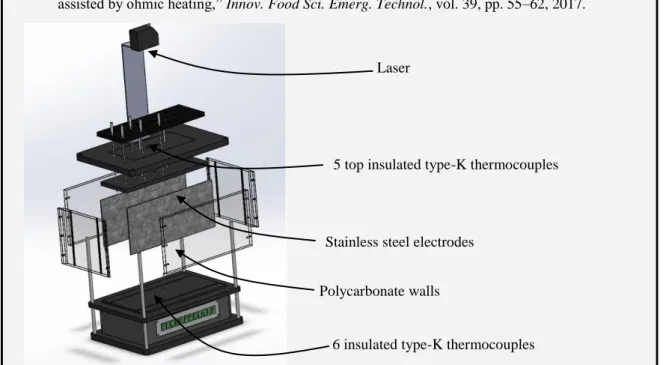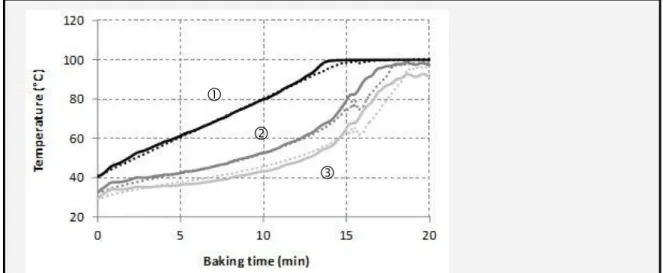HAL Id: hal-01833540
https://hal.archives-ouvertes.fr/hal-01833540
Submitted on 9 Jul 2018
HAL is a multi-disciplinary open access
archive for the deposit and dissemination of
sci-entific research documents, whether they are
pub-lished or not. The documents may come from
teaching and research institutions in France or
abroad, or from public or private research centers.
L’archive ouverte pluridisciplinaire HAL, est
destinée au dépôt et à la diffusion de documents
scientifiques de niveau recherche, publiés ou non,
émanant des établissements d’enseignement et de
recherche français ou étrangers, des laboratoires
publics ou privés.
3D Numerical modelling of crustless bread baking with
ohmic heating technology
Timothée Gally, Olivier Rouaud, Vanessa Jury, Alain Le-Bail, Michel Havet
To cite this version:
Timothée Gally, Olivier Rouaud, Vanessa Jury, Alain Le-Bail, Michel Havet. 3D Numerical modelling
of crustless bread baking with ohmic heating technology. Food Sci. Emerg. Technol, 2017, 39, pp.55
- 62. �hal-01833540�
Important notes:
Do NOT write outside the grey boxes. Any text or images outside the boxes will be deleted.
Do NOT alter the structure of this form. Simply enter your information into the boxes. The form will be automatically processed – if you alter its structure your submission will not be processed correctly. Do not include keywords – you can add them when you submit the abstract online.
Title:
3D Numerical modelling of crustless bread baking with ohmic heating technology
Authors & affiliations:
Timothée GALLYa,b,c, Olivier ROUAUDa,b,c, Vanessa JURYa,b,c, Alain LE-BAILa,b,c, Michel HAVETa,b,c a ONIRIS, CS 82225, 44322 Nantes– France
b UMR GEPEA CNRS 6144 - ONIRIS, 44307 Nantes – France c
UBL (Université Bretagne Loire)
Abstract: (Your abstract must use Normal style and must fit in this box. Your abstract should be no longer than 300 words. The box will ‘expand’ over 2 pages as you add text/diagrams into it.)
Ohmic heating (OH) is an electromagnetic based method, in which an electric current is passed through a foodstuff in order to heat it up by its own electrical resistance. Its main advantages are the possibility to reach very high heating rates, the absence of thermal inertia (instant shut-off of the system) and its volumetric heating, leading to a very high energy efficiency. If OH is already used in the food industry for the heat treatment of liquid products in continuous processes, its application to solid foodstuffs in batch production is scarce and even non-existent in the case of bread baking.
To check the baking and the quality of bread, temperature and water content have to be evaluated during ohmic heating. Because non intrusive measurement of such characteristics is difficult and/or onerous, numerical simulation is viewed as a very interesting tool.
In this work, a 3D numerical model was developed to study the heat and mass transfer in a commercial-sized crustless sandwich bread. The objective was to locate the sensitive spots (high and low temperature locations) during a potential industrial baking and to know more about the impact of the process on the final water content of the product. The model was validated by experimental tests realized on a prototype (figure 1) developed in our lab [1] and provided a quite good accuracy in terms of temperatures (figure 2) and water contents. Especially, numerical results have shown that there could be strong temperature gradients close to the electrodes and that the distribution of moisture content was the inverse of that resulting from a conventional heating.
[1] T. Gally, O. Rouaud, V. Jury, M. Havet, A. Ogé, and A. Le-Bail, “Proofing of bread dough assisted by ohmic heating,” Innov. Food Sci. Emerg. Technol., vol. 39, pp. 55–62, 2017.
Figure 1. Sketch of the prototype of the electric resistance oven.
Laser
5 top insulated type-K thermocouples
Stainless steel electrodes
Polycarbonate walls
Important notes:
Do NOT write outside the grey boxes. Any text or images outside the boxes will be deleted.
Do NOT alter the structure of this form. Simply enter your information into the boxes. The form will be automatically processed – if you alter its structure your submission will not be processed correctly. Do not include keywords – you can add them when you submit the abstract online.
Figure 2. Experimental (dashed lines) and numerical results (straight lines) for the temperatures:

